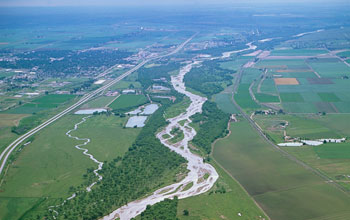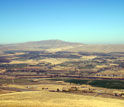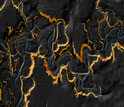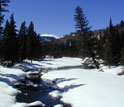News Release 12-174
How Is Earth's Water System Linked With Land Use, Climate Change and Ecosystems?
Answers may be in new NSF Water Sustainability and Climate research

A WSC project will look at Colorado's South Platte River: From mountains to urban lands.
September 24, 2012
This material is available primarily for archival purposes. Telephone numbers or other contact information may be out of date; please see current contact information at media contacts.
How will climate change affect the connections between water sustainability and hydrologic processes?
To better understand how planet Earth's water cycle works, the National Science Foundation (NSF) and the United States Department of Agriculture's National Institute of Food and Agriculture (NIFA) awarded grants totaling almost $27 million through the Water Sustainability and Climate program.
WSC is part of NSF's Science, Engineering and Education for Sustainability investment.
NSF's Directorates for Geosciences; Engineering; and Social, Behavioral & Economic Sciences support the WSC awards.
"Among the most urgent challenges facing the world today is ensuring the adequate supply and quality of water, especially in light of burgeoning human needs and climate variability and change," says Marge Cavanaugh, NSF acting assistant director for Geosciences.
"Whereas the water imperative is global, WSC recognizes that water availability and quality issues must be examined at local scales where most water decisions are made," says Cavanaugh. "That's why WSC projects are placed-based, and each examines how global and regional climate changes are playing out in terms of water balance at the local scale."
WSC Category 1 awards are workshop planning grants; WSC Category 2 grants cover observatories and modeling; WSC Category 3 awards are for modeling.
"Water is a critical component to the success of American agriculture, yet there is a lack of understanding of how climate variability, land use and other environmental factors affect the water supply," says Sonny Ramaswamy, director of the National Institute of Food and Agriculture. "These projects will allow us to better understand water sustainability and allow our producers and rural communities to prepare for future changes."
The goal of the new WSC projects--including studies of Rocky Mountain pine beetles, Los Angeles' water supply and the Sierra Nevada snowpack--is to understand and predict the interactions of Earth's water system with climate change, land use, the built environment and ecosystem function and services.
For example, more than four million acres of forests in Colorado and Wyoming are dying. The main culprit is the mountain pine beetle, a species of bark beetle native to the woodlands of western North America. Recent hot, dry summers and mild winters have led to an infestation of the beetles. It may be the largest forest insect blight ever seen in North America.
The result is stunning: dead trees lined up like so many fallen forest soldiers. But the invisible changes in watersheds in the Rocky Mountains, including the headwaters of the Platte and Colorado Rivers, may be a longer-lasting legacy.
Farther west, Los Angeles, like many cities in semi-arid regions, relies on centralized redistribution for its water supply. Water is transported hundreds of miles from mountain to city to support agricultural and urban needs in southern California. But water allocations from the mountain sources that feed L.A.'s water supply are declining. Drought, over-extraction and competing water needs have taken their toll.
In many arid and semi-arid regions of the world, including much of the western United States, water resources management plans are based on the assumption that the snowpack that accumulates in winter holds the majority of the water. This snowpack gradually melts, replenishing reservoirs as their supplies are meted out to satisfy human water and power demands.
Nowhere is that more true than in California's Sierra Nevada. This remote and sparsely populated mountain range supplies water and power for millions of people downstream. Will the Sierras be able to sustain that supply in the decades and centuries to come?
Only 2.5 percent of Earth's water is freshwater, and 98.8 percent of that is locked away in ice or hidden in groundwater. Less than 0.3 percent of all freshwater is in lakes, rivers and the atmosphere.
How can we better manage and predict water availability for future generations, given alterations to the water cycle caused by climate change and by more direct human activities?
The answers require a holistic understanding of complex water cycle and water resource processes, the feedbacks in a water system, and the vulnerability and resilience of water systems to climate and other human-caused change.
A water system comprises a drainage basin and its physical, chemical and biological constituents, including water networks, ecosystems, the built environment, the oceanic and atmospheric systems that govern evaporation and precipitation in the basin and the source water bodies and terminal lakes or seas into which the water flows.
There have been few attempts to study the entire water system with an integrative, systems science approach. WSC researchers will do just that.
This analysis of the planet's water system--of the feedbacks and links among climate change, ecosystems, built environments and human activities--will lead to the improved understanding, prediction and management of water resources, scientists believe.
"Earth has approximately 1,386 million cubic kilometers of water, most of which is the saltwater of oceans and seas," says Cavanaugh.
"What decisions will we make about the rest, the freshwater that's 'technically' available to us? Those decisions are for societies to make, and water sustainability researchers are working through WSC to fully inform those complex decisions."
NSF Science, Engineering and Education for Sustainability WSC 2012 awardees and their research projects are:
Brozovic, Nicholas, University of Illinois at Urbana-Champaign:
WSC-Category 1: Development of an Integrated Economic-Hydrologic-Ecologic Framework for Resilient Surface Water-Groundwater Management
Duke, Joshua, University of Delaware:
WSC Category 1 Water Sustainability in Coastal Environments: Exploratory Research for an Integrated Study of the Effect of Anticipated Sea Level Rise on Contaminated Site Risk
Felkner, John, Florida State University:
WSC-Category 1: Integrative Modeling of the Interactions, Connectivity and Interdependence of Water Systems and Ecosystem Services in the Lower Mekong Basin
Johannesson, Karen, Tulane University:
WSC-Category 1: From Natural Wetland to Murky Water: Cross-disciplinary Analysis of a Drowning Urbanized Coast
Arumugam, Sankarasubraman, North Carolina State University:
WSC- Category 3: Collaborative Research: Water Sustainability under Near-term Climate Change : A Cross-regional Analysis Incorporating Socio-ecological Feedbacks and Adaptations
Pataki, Diane, University of Utah:
WSC-Category 3: Collaborative: The Role of Local Water Resources in the Water Sustainability of Los Angeles
Arabi, Mazdak, Colorado State University:
WSC-Category 3: Assessing Water Management Tradeoffs and Targets under Climatic and Land Use Uncertainty
Molotch, Noah, University of Colorado at Boulder:
WSC Category 3, Collaborative Research: Snowpack and Ecosystem Dynamics: The Sustainability of Inter-basin Water Transfers under a Changing Climate
Orr, Cailin, Washington State University:
WSC-Category 3: Watershed Integrated System Dynamics Modeling (WISDM): Feedbacks among Biogeochemical Simulations, Stakeholder Perceptions, and Behavior
Harmon, Thomas, University of California - Merced:
WSC Category 3: Propogating Climate-Driven Changes in Hydrologic Processes and Ecosystem Functions across Extreme Biophysical and Anthropogenic Gradients
Georgescu, Matei, Arizona State University:
WSC-Category 3: Sustainable Large-Scale Deployment of Perennial Biomass Energy Crops
Foufoula-Georgiou, Efi, University of Minnesota-Twin Cities:
WSC-Category 2, Collaborative: Climate and Human Dynamics as Amplifiers of Natural Change: a Framework for Vulnerability Assessment and Mitigation Planning
Hornberger, George, Vanderbilt University:
Climate, Drought, and Agricultural Adaptations: An Investigation of Vulnerabilities and Responses to Water Stress Among Paddy Farmers in Sri Lanka
Maxwell, Reed, Colorado School of Mines:
WSC-Category 2, Collaborative: Water Quality and Supply Impacts from Climate-induced Insect Tree Mortality and Resource Management in the Rocky Mountain West
-NSF-
-
WSC scientists will study the watershed of the Yakima River Basin in Washington State.
Credit and Larger Version -
LIDAR image of very steep areas (orange) along the Minnesota River: Hotspots of change.
Credit and Larger Version -
The Lower San Joaquin River in California is fed by water releases from Friant Dam.
Credit and Larger Version -
Headwaters of the Rio Grande River in Colorado; snowmelt is the river's main water source.
Credit and Larger Version -
WSC researchers talk about paddy irrigation with a farmer in Sri Lanka.
Credit and Larger Version
Media Contacts
Cheryl Dybas, NSF, (703) 292-7734, email: cdybas@nsf.gov
Related Websites
NSF Awards First Grants for Study of Water Sustainability and Climate: http://www.nsf.gov/news/news_summ.jsp?cntn_id=117819
NSF Discovery Article: Cry Me a River: Following a Watershed's Winding Path to Sustainability: http://www.nsf.gov/discoveries/disc_summ.jsp?cntn_id=123431&org=NSF
NSF SEES Discovery Articles Publication: http://www.nsf.gov/pubs/2012/disco12001/disco12001.pdf
Science, Engineering and Education for Sustainability NSF-Wide Investment (SEES): http://www.nsf.gov/sees
The U.S. National Science Foundation propels the nation forward by advancing fundamental research in all fields of science and engineering. NSF supports research and people by providing facilities, instruments and funding to support their ingenuity and sustain the U.S. as a global leader in research and innovation. With a fiscal year 2023 budget of $9.5 billion, NSF funds reach all 50 states through grants to nearly 2,000 colleges, universities and institutions. Each year, NSF receives more than 40,000 competitive proposals and makes about 11,000 new awards. Those awards include support for cooperative research with industry, Arctic and Antarctic research and operations, and U.S. participation in international scientific efforts.
Connect with us online
NSF website: nsf.gov
NSF News: nsf.gov/news
For News Media: nsf.gov/news/newsroom
Statistics: nsf.gov/statistics/
Awards database: nsf.gov/awardsearch/
Follow us on social
Twitter: twitter.com/NSF
Facebook: facebook.com/US.NSF
Instagram: instagram.com/nsfgov







